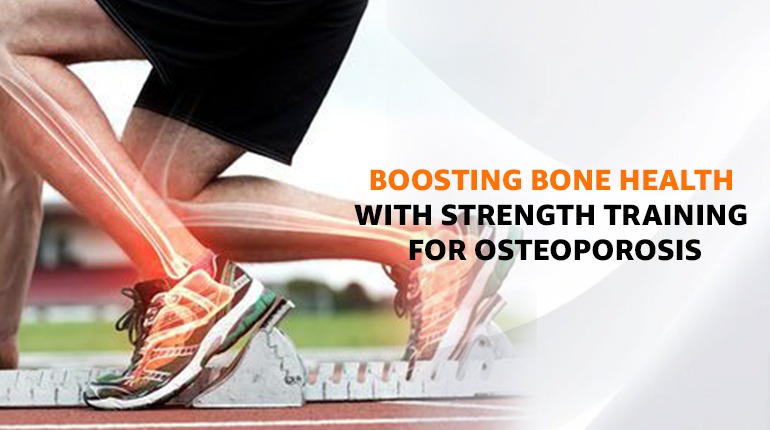Building Strong Bones: The Power of Strength Training for Osteoporosis

Osteoporosis is a widespread condition with significant effects. It is characterized by a progressive thinning of the bones, making them increasingly brittle and prone to fracture. A sizable portion of the planet is impacted by this ailment. We hope to shed some light on osteoporosis, including what it is, its causes, risk factors, and—most importantly—how a potent ally in addressing and overcoming the difficulties this condition brings is strength training for osteoporosis to be managed effectively. Learn how strength training strengthens bone health, whether you are familiar with the subject or are unfamiliar with it.
Understanding Osteoporosis

Osteoporosis is a condition that gradually reduces bone density, making bones brittle and prone to fractures. It primarily affects older adults, especially post-menopausal women, but it can strike at any age.
One of the key factors contributing to the phenomenon of bone thinning is the gradual reduction in bone density. This decrease in bone mass can render bones more fragile, akin to the brittleness of a dry twig. Even minor accidents or falls can result in fractures, a concern for many individuals.
The Role of Strength Training for Osteoporosis Management
Now, here’s how strength training for osteoporosis can be a game-changer in the battle against the disease. You might be picturing bulging muscles and heavyweights, but fear not, because strength training for osteoporosis I’s about helping your bones regain their strength and resilience and not bulking up.
1. Building Bone Density
Strength training, also called resistance training, uses resistance from various sources like dumbbells, resistance bands, or body weight to work muscles. During these exercises, muscles exert force on bones, signaling the body to strengthen bones by increasing bone density.
2. Improved Muscle Strength and Balance
Besides boosting bone density, strength training improves muscle strength and balance. This is because strong muscles help protect your bones by reducing the risk of falls. A strong body is less likely to wobble or lose balance, making you more resilient in everyday situations.
3. Enhanced Joint Health
Strength training isn’t just about bones and muscles; it also benefits your joints. By working on your joint flexibility and stability, it can help you move more comfortably and with less risk of injury. This is especially important for individuals with osteoporosis, as they may already be dealing with joint issues.
Also Read: Empower your Recovery With 9 Treadmill Benefits For Rehabilitation
Getting Started with Strength Training
Now, you might be wondering how to kick-start your strength training journey. The good news is that you don’t need to be a fitness guru or have a home gym filled with expensive equipment. You can begin with some simple, at-home exercises that are both effective and safe.
Here are some strength training exercises that can help:
1. Bodyweight Squats

– First, stand with your feet shoulder-width apart.
– Slowly lower your body by bending your knees and hips, as if you were sitting back into a chair.
– Keep your back straight and chest up.
– Lower yourself as far as you can comfortably go, ideally until your thighs are parallel to the ground.
– Push through your heels to stand back up.
2. Wall Push-Ups

– Stand facing a wall, about arm’s length away.
– Place your hands on the wall at shoulder height.
– Lean forward and bend your elbows to bring your chest toward the wall.
– Push back to the starting position.
– Adjust the distance from the wall to increase or decrease the intensity.
3. Seated Leg Raises
– Sit in a sturdy chair with your feet flat on the floor.
– Lift one leg straight out in front of you while keeping your knee straight.
– Hold for a few seconds, then lower it back down.
– Repeat with the other leg.
4. Resistance Band Exercises
– Attach a resistance band to a stable anchor point.
– Perform exercises such as bicep curls, tricep extensions, or lateral raises using the resistance band to create resistance.
– These exercises can target various muscle groups and can be adjusted to your fitness level by using different band tensions.
5. Dumbbell Exercises
– If you have access to dumbbells, consider exercises like dumbbell rows, dumbbell lunges, or dumbbell chest presses.
– Start with a weight that is manageable and gradually increase it as you become stronger.
6. Planks
– Lie face down on the floor, propped up on your elbows and toes.
– Keep your body in a straight line from head to heels.
– Engage your core muscles and hold this position for as long as you can.
– This exercise strengthens your core and can help with overall stability.
Remember to start with exercises that match your current fitness level and gradually progress in terms of repetitions, sets, and weight as you become more comfortable. It’s essential to maintain proper form to prevent injury, and consulting with a fitness professional or physical therapist can provide valuable guidance tailored to your specific needs and limitations.
Conclusion and Your Next Steps
Finally, strength training isn’t just for the muscle-bound gym-goers. It’s a powerful tool that can help you regain bone density, improve muscle strength and balance, and enhance joint health. By incorporating strength training for osteoporosis management into your routine and maintaining a bone-friendly diet, you’re taking proactive steps to combat osteoporosis.
Aim for at least two to three sessions per week. Your sessions don’t need to be lengthy; even 30 minutes can make a significant difference. Your diet plays a vital role in bone health. Ensure you’re getting enough calcium and vitamin D, both of which are essential for bone strength. Incorporate dairy products, leafy greens, and fortified foods into your diet.
Start with those bodyweight exercises, grab some resistance bands, or give those dumbbells a try. Seek guidance from a fitness professional if needed, and remember, consistency is key.
Also Read: How to Meditate for Anxiety: 7 Effective Practices

